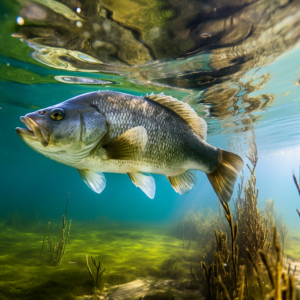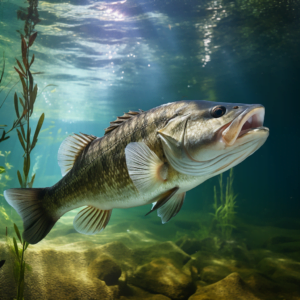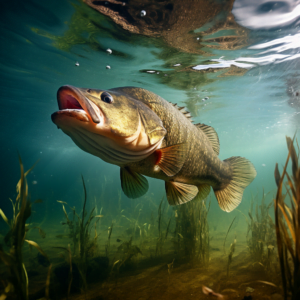Ever wondered why you can grab a bass by the mouth? It’s almost like they’re asking for it! Well, let me tell you, there’s actually some science behind it. You see, bass have a special mechanism in their mouth that allows them to capture prey with ease. In fact, their mouths are equipped with a unique structure known as the jaw hinge, which enables them to create a vacuum-like suction to snatch up their food. It’s like a built-in vacuum cleaner that just sucks up anything that comes near its mouth!
Now, you might be thinking, how does this information help me catch more bass? Well, understanding the science behind it can actually give you an advantage on the water. By knowing that bass rely on their mouth to grab their prey, you can strategically choose your lures and bait to mimic their natural food sources. For example, using lures that resemble small fish or insects can trick the bass into biting, as they instinctively go for anything that looks like a meal. So, in a way, knowing the science behind catching bass by the mouth can make you a more successful angler.
In our upcoming article, we’ll delve deeper into the fascinating world of bass fishing and explore other factors that can influence their feeding behavior. From the types of lures and bait to the different fishing techniques, we’ll cover it all. So, stay tuned and get ready to dive into the science behind catching bass by the mouth. You’ll come away with a newfound appreciation for these incredible creatures and maybe even some tips to help you reel in that big one!
The Basic Anatomy of a Bass
When it comes to catching bass, understanding the science behind their mouth is essential. The mouth of a bass is a complex and remarkable structure that plays a pivotal role in its feeding behavior and ultimately, in your ability to successfully reel in your catch. In this article, we will explore the intricacies of a bass’s mouth, the sensors it possesses, the various adaptations it has developed, and how these factors influence its feeding habits.
| Aspect | Detail |
|---|---|
| Species | Bass |
| Habitat | Freshwater bodies (lakes, rivers, ponds) |
| Primary Diet | Smaller fish, insects, and crustaceans |
| Feeding Behavior | Ambush predators, Selective feeding |
| Lure Preferences | Plastic worms, Crankbaits, Topwater lures |
| Mouth Anatomy | Jaw hinge, Pressure and taste sensors, Specialized cells (proprioceptors) |
| Preferred Water Temp | Varies with species; bass generally active in 55°F – 85°F, with optimal around 65°F – 75°F |
| Fishing Techniques | Utilizing lures mimicking preferred prey, Casting near structures, Slow retrieval speeds |
| Ethical Practices | Catch and release, Proper handling techniques, Using appropriate gear, Avoiding overfishing |
| Conservation Note | Advocacy for sustainable fishing, respecting aquatic habitats |
The Structure of the Bass’s Mouth
The mouth of a bass is designed to be a powerful weapon for capturing prey. It is located on the front of the fish’s body, lined with rows of sharp teeth. The size of the mouth can vary among bass species, but they all share common characteristics. The upper and lower jaws are connected by a joint, allowing the fish to open its mouth wide when striking at prey. This flexibility allows for a greater range of movement and the ability to engulf larger prey.
The Function of the Bass’s Mouth
The primary function of a bass’s mouth is to capture and consume prey. The bass is an active predator that feeds on a variety of aquatic organisms, including smaller fish, insects, and crustaceans. The shape and size of its mouth determine its ability to target specific prey types. The mouth is also equipped with an intricate sensory system, which helps the bass locate and capture food efficiently.
Sensors in a Bass’s Mouth
Taste Buds in the Bass’s Mouth
One of the key sensory organs in the bass’s mouth is its taste buds. These taste buds are present on the tongue, roof of the mouth, and the back of the throat. They allow the fish to detect different chemicals in the water and distinguish between edible and inedible substances. This ability to taste helps the bass select appropriate prey items and avoid potential toxins or unsuitable food sources.
Pressure Sensors in the Bass’s Mouth
Another crucial sensor in the bass’s mouth is the pressure sensors. These sensors are located in the jaws and enable the fish to detect changes in pressure caused by nearby prey. When a bass detects vibrations or disturbances in the water, it can identify the potential presence of prey and react accordingly. This heightened sensitivity allows the bass to strike with precision, increasing its chances of a successful catch.
Detecting Movement through the Bass’s Mouth
The bass’s mouth also contains specialized cells that can detect movement. These cells, known as proprioceptors, are located in the muscles and ligaments of the jaw. They provide the fish with a sense of its own movements, allowing it to coordinate its strikes accurately. By relying on these proprioceptors, the bass can anticipate the movements of its prey and respond swiftly and effectively.
Feeding Behavior of Bass
Ambush Predators
Bass are renowned for their ambush feeding behavior. They often lie in wait, hidden among plants or near structures such as fallen trees or rocks. When unsuspecting prey comes within striking distance, the bass lunges forward, using its powerful jaws to capture the prey. This ambush strategy relies heavily on the bass’s ability to blend into its surroundings and strike before the prey has a chance to escape.
Selective Feeding
Despite being voracious predators, bass exhibit selective feeding behavior. They are known to prefer certain types of prey depending on factors such as availability, season, and habitat. Bass have been observed to show a preference for prey that provides high energy content, such as small minnows or crayfish. This selectivity allows the bass to optimize its feeding efficiency and meet its nutritional needs effectively.
Lure Preferences
When it comes to recreational fishing, understanding a bass’s preference for certain types of lures can significantly increase your chances of a successful catch. Bass are attracted to lures that imitate their preferred prey, such as plastic worms, crankbaits, or topwater lures. By using these lures, you can effectively entice the bass into striking, mimicking the natural movement and appearance of their preferred prey.
Mouth Size and Adaptations
Variations in Mouth Sizes
Bass species exhibit variations in their mouth sizes, which correspond to their preferred prey types and feeding strategies. Some species have smaller mouths, suited for feeding on insects or small crustaceans, while others have larger mouths, allowing them to consume larger prey such as small fish. The size and shape of the mouth are closely linked to the specific ecological niche that the bass occupies.
Adaptations for Different Prey Types
The mouth of a bass has evolved to adapt to their preferred prey types. Bass that primarily feed on insects or crustaceans have narrower mouths with specialized structures, such as bristle-like teeth or gill rakers, which help filter out small particles and prevent the escape of prey. Bass that target larger fish have wider mouths and more robust jaws, allowing them to engulf their prey more efficiently.
The Relationship between Mouth Size and Growth
The size and growth rate of a bass can be influenced by the size of its mouth. Bass with larger mouths have a higher potential to consume larger prey, which can lead to rapid growth and development. Conversely, bass with smaller mouths may have to rely on smaller prey items, resulting in slower growth rates. The interplay between mouth size and growth highlights the importance of a bass’s feeding capacity in determining its overall size and fitness.
Competition for Prey
Intraspecific Competition
Within a bass population, competition for prey resources can be intense. Bass of similar size and feeding preferences may compete directly with each other, leading to a limited availability of food. This competition drives bass to become more aggressive and opportunistic in their feeding behavior, as they strive to secure enough food to survive and thrive.
Interspecific Competition
Bass also face competition from other fish species that share their habitat and feed on the same prey. Fish such as pike, walleye, or even other bass species may compete with bass for food resources. This competition forces bass to evolve specialized feeding strategies or adapt to different feeding times or locations to minimize direct competition and ensure their survival.
Bass Jaw Mechanics
The Power of Muscles in the Bass’s Jaw
The jaw muscles of a bass are exceptionally powerful, allowing the fish to deliver swift and forceful strikes. Bass have well-developed adductor muscles, which are responsible for closing the jaw with tremendous force. These muscles provide the necessary strength to capture and hold onto struggling prey, ensuring a successful catch.
The Role of Bones and Ligaments
In addition to strong muscles, the bones and ligaments of the bass’s jaw play a crucial role in its feeding mechanics. The bones provide structural support, allowing the jaw to withstand the forces exerted during strikes and captures. Ligaments help to stabilize the jaw, ensuring precise and controlled movements during feeding.
Jaw Protrusion and Suction Feeding
Bass are also capable of protruding their jaws, a unique adaptation that allows them to create a suction force. By protruding their lower jaw, bass can rapidly expand the volume of their mouth, creating a vacuum-like effect. When combined with a quick closing of the mouth, this suction force enables the bass to engulf prey more efficiently, increasing its chances of a successful capture.
Hunting Techniques
Ambush Hunting
As mentioned earlier, bass are well-known for their ambush hunting technique. They remain motionless, concealed in their surroundings, and strike with lightning speed when prey comes within range. This hunting style requires precise timing, coordination, and the ability to deliver a powerful bite, all of which are facilitated by the structure and function of the bass’s mouth.
Chasing and Pursuit
While ambush hunting is the preferred method for capturing prey, bass also engage in active chasing and pursuit when necessary. When prey is too fast or elusive to be captured through an ambush, bass will engage in rapid pursuit, using their speed and agility to outmaneuver their prey. The muscular jaw combined with the suction force allows the bass to strike swiftly and effectively in these pursuit scenarios.
Swallowing and Digestion
Once a bass captures its prey, the complex structure of its mouth facilitates efficient swallowing. The mobility of the bass’s jaw, along with its expandable throat, enables it to swallow prey whole, without the need for extensive chewing. The prey then moves through the digestive tract, where the bass’s digestive enzymes break it down into nutrients that can be absorbed and utilized for growth and energy.
Environmental Factors
Water Temperature and Bass Feeding
Water temperature plays a significant role in a bass’s feeding behavior. Bass are ectothermic creatures, meaning their body temperature is dependent on their environment. As water temperature increases, the metabolic rate and activity levels of bass also increase. This higher activity level translates into increased feeding and foraging behavior as bass become more energetic and responsive to potential prey.
Water Clarity and Bass Feeding
Water clarity directly impacts a bass’s ability to detect and capture prey. Bass rely on their senses, particularly their vision, to locate and strike at prey. In clear water conditions, bass can visually target their prey more effectively, increasing their hunting success. In contrast, murky water reduces visibility, making it more difficult for bass to locate prey solely based on visual cues. In such conditions, bass may rely more heavily on other sensory inputs, such as smell or pressure changes, to detect and capture prey.
Human Interaction and Catching Bass
Fishing Techniques
When it comes to catching bass, understanding the science behind their mouth can provide valuable insights. By utilizing lures that mimic the bass’s preferred prey, anglers can increase their chances of enticing a strike. Additionally, knowledge of a bass’s feeding behavior, such as their propensity for ambush hunting, can inform fishing techniques, such as casting near structures or using slow retrieval speeds. This understanding of the bass’s mouth and feeding habits allows anglers to strategically target and catch bass more effectively.
Ethical Considerations
While catching bass can be an exciting and rewarding experience, it is crucial to consider ethical practices. Catch and release fishing, where the bass is returned unharmed to the water after capture, is a common approach that helps preserve and sustain bass populations. Ensuring proper handling techniques, using appropriate gear, and avoiding overfishing are all essential considerations when engaging in bass fishing. By practicing responsible fishing, we can enjoy this recreational activity while contributing to the conservation of bass populations.
Conclusion
The mouth of a bass is an incredible adaptation that enables it to be a successful predator. From the structure and function of its powerful jaws to the complex sensory systems that aid in locating and capturing prey, the science behind a bass’s mouth is fascinating. By understanding the intricacies of the bass’s mouth and its feeding behaviors, we can not only appreciate the remarkable biology of these fish but also enhance our abilities to catch them. So, the next time you cast your line, remember the science behind a bass’s mouth and reel in that trophy catch with confidence!




